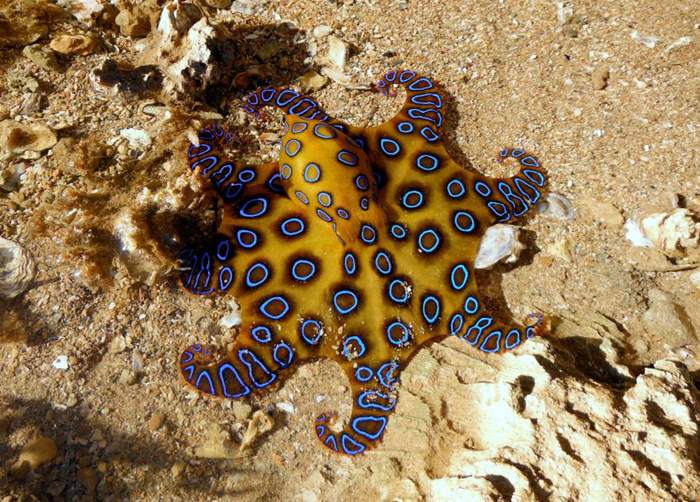|
|
|||
|
|
|
|
|
|
|
|||
BLUE RINGED OCTOPUSHapalochlaena
(c) TJ Paris - My Blue Ringed Octopus Encounter
|
|
|
|
|
|
WE NEED YOUR SUPPORT. |
|
|
|
|
This small octopus has the distinction of being one of the most deadly creatures in the country. It is small (usually only 5-10cm across) and unlike other octopus, it has short tentacles. If approached it will usually brighten its blue markings to a point where they almost appear to glow.
They are found mostly in the tropics but can occur anywhere around the coast. They should never, under any circumstances, be handled.
If you are gathering bait or exploring exposed reef in areas that this creature is likely to inhabit, take great care if you pick up large shells and refrain from putting your fingers under rocks.
Keep an eye on children who may want to explore exposed reef at low tide as the octopus move about from one tidal pool to another at this time.
They can release their toxin directly into the water and it can be dangerous if you have an open wound.
There are 4 different species of blue ringed octopus although one species (Hapalochlaena nierstraszi) was described from a single specimen and there remains some doubt about whether it really was a different species at all.
The three fully recognised species are; Greater Blue-ringed Octopus, Hapalochlaena lunulata, The Lesser Blue-ringed Octopus, Hapalochlaena maculosa and The Blue-lined Octopus, Hapalochlaena fasciata. All are found in Australian coastal waters.
Like other octopus species the female will have only one clutch of eggs in her lifetime. She attaches about 50 eggs in a sheltered hole and will tend them without eating for 6 months until they hatch. At this time the female is so weakened by the lack of food that she will die.
Blue ringed octopus are known to be cannibalistic and females have been observed killing and eating males with whom they have just mated.
The venom (tetrodotoxin) produced by bacteria in the salivary glands of the the octopus, is said to be ten thousand times more potent than cyanide. Currently there is no anti-venom available and death is usually from suffocation brought on by oxygen starvation.
If someone is bitten by a blue ringed octopus then artificial respiration MUST be administered until the victim regains the ability to breathe on their own. This can take many hours but respiration has to continue in order for the person bitten to recover.
Someone bitten by a blue ringed octopus may suffer complete paralysis but they are still fully conscious even if they cannot respond. The first 24 hours are critical and most people who are still alive after this will recover completely.
The octopus carries enough venom to kill at least 10 adult human beings. Bites are often painless and people may not realise they have been bitten until the first signs of paralysis begin to show.
Some people actually keep these creatures in home aquariums but this is a bad idea for a number of reasons. First and most importantly, the octopus can KILL YOU. They frequently escape from tanks and are very difficult to contain. Secondly they do not live very long and do not long survive transportation and finally they are comparatively rare in the wild and the continued removal of adults for the fish tank trade will eventually have serious consequences for the species.
|
|
Become a supporter of this website for just $5 a month
|







